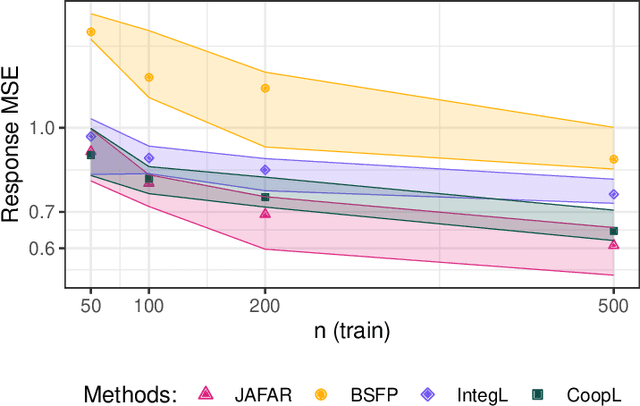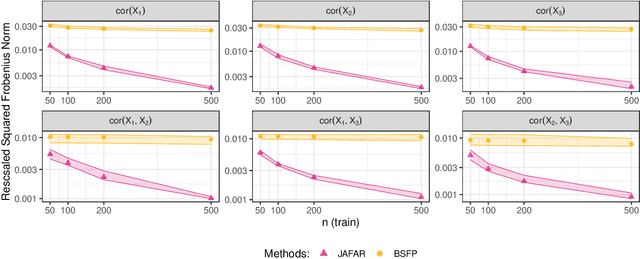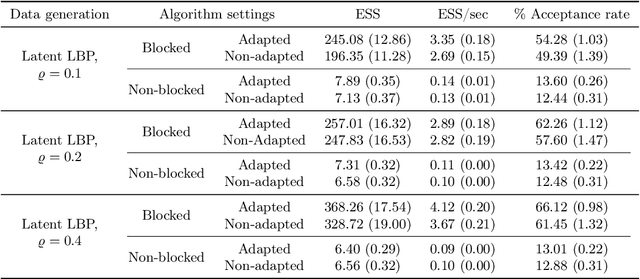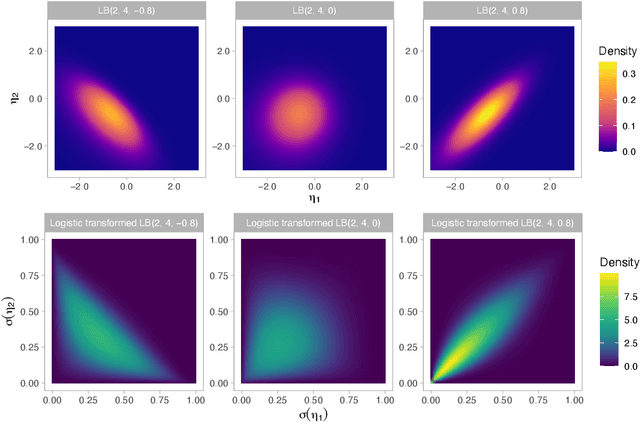David B. Dunson
Learning Discrete Bayesian Networks with Hierarchical Dirichlet Shrinkage
Sep 16, 2025Abstract:Discrete Bayesian networks (DBNs) provide a broadly useful framework for modeling dependence structures in multivariate categorical data. There is a vast literature on methods for inferring conditional probabilities and graphical structure in DBNs, but data sparsity and parametric assumptions are major practical issues. In this article, we detail a comprehensive Bayesian framework for learning DBNs. First, we propose a hierarchical prior for the conditional probabilities that enables complicated interactions between parent variables and stability in sparse regimes. We give a novel Markov chain Monte Carlo (MCMC) algorithm utilizing parallel Langevin proposals to generate exact posterior samples, avoiding the pitfalls of variational approximations. Moreover, we verify that the full conditional distribution of the concentration parameters is log-concave under mild conditions, facilitating efficient sampling. We then propose two methods for learning network structures, including parent sets, Markov blankets, and DAGs, from categorical data. The first cycles through individual edges each MCMC iteration, whereas the second updates the entire structure as a single step. We evaluate the accuracy, power, and MCMC performance of our methods on several simulation studies. Finally, we apply our methodology to uncover prognostic network structure from primary breast cancer samples.
Spectral decomposition-assisted multi-study factor analysis
Feb 20, 2025Abstract:This article focuses on covariance estimation for multi-study data. Popular approaches employ factor-analytic terms with shared and study-specific loadings that decompose the variance into (i) a shared low-rank component, (ii) study-specific low-rank components, and (iii) a diagonal term capturing idiosyncratic variability. Our proposed methodology estimates the latent factors via spectral decompositions and infers the factor loadings via surrogate regression tasks, avoiding identifiability and computational issues of existing alternatives. Reliably inferring shared vs study-specific components requires novel developments that are of independent interest. The approximation error decreases as the sample size and the data dimension diverge, formalizing a blessing of dimensionality. Conditionally on the factors, loadings and residual error variances are inferred via conjugate normal-inverse gamma priors. The conditional posterior distribution of factor loadings has a simple product form across outcomes, facilitating parallelization. We show favorable asymptotic properties, including central limit theorems for point estimators and posterior contraction, and excellent empirical performance in simulations. The methods are applied to integrate three studies on gene associations among immune cells.
On the Statistical Capacity of Deep Generative Models
Jan 14, 2025Abstract:Deep generative models are routinely used in generating samples from complex, high-dimensional distributions. Despite their apparent successes, their statistical properties are not well understood. A common assumption is that with enough training data and sufficiently large neural networks, deep generative model samples will have arbitrarily small errors in sampling from any continuous target distribution. We set up a unifying framework that debunks this belief. We demonstrate that broad classes of deep generative models, including variational autoencoders and generative adversarial networks, are not universal generators. Under the predominant case of Gaussian latent variables, these models can only generate concentrated samples that exhibit light tails. Using tools from concentration of measure and convex geometry, we give analogous results for more general log-concave and strongly log-concave latent variable distributions. We extend our results to diffusion models via a reduction argument. We use the Gromov--Levy inequality to give similar guarantees when the latent variables lie on manifolds with positive Ricci curvature. These results shed light on the limited capacity of common deep generative models to handle heavy tails. We illustrate the empirical relevance of our work with simulations and financial data.
Fast nonparametric feature selection with error control using integrated path stability selection
Oct 03, 2024



Abstract:Feature selection can greatly improve performance and interpretability in machine learning problems. However, existing nonparametric feature selection methods either lack theoretical error control or fail to accurately control errors in practice. Many methods are also slow, especially in high dimensions. In this paper, we introduce a general feature selection method that applies integrated path stability selection to thresholding to control false positives and the false discovery rate. The method also estimates q-values, which are better suited to high-dimensional data than p-values. We focus on two special cases of the general method based on gradient boosting (IPSSGB) and random forests (IPSSRF). Extensive simulations with RNA sequencing data show that IPSSGB and IPSSRF have better error control, detect more true positives, and are faster than existing methods. We also use both methods to detect microRNAs and genes related to ovarian cancer, finding that they make better predictions with fewer features than other methods.
Bayesian Joint Additive Factor Models for Multiview Learning
Jun 02, 2024



Abstract:It is increasingly common in a wide variety of applied settings to collect data of multiple different types on the same set of samples. Our particular focus in this article is on studying relationships between such multiview features and responses. A motivating application arises in the context of precision medicine where multi-omics data are collected to correlate with clinical outcomes. It is of interest to infer dependence within and across views while combining multimodal information to improve the prediction of outcomes. The signal-to-noise ratio can vary substantially across views, motivating more nuanced statistical tools beyond standard late and early fusion. This challenge comes with the need to preserve interpretability, select features, and obtain accurate uncertainty quantification. We propose a joint additive factor regression model (JAFAR) with a structured additive design, accounting for shared and view-specific components. We ensure identifiability via a novel dependent cumulative shrinkage process (D-CUSP) prior. We provide an efficient implementation via a partially collapsed Gibbs sampler and extend our approach to allow flexible feature and outcome distributions. Prediction of time-to-labor onset from immunome, metabolome, and proteome data illustrates performance gains against state-of-the-art competitors. Our open-source software (R package) is available at https://github.com/niccoloanceschi/jafar.
Logistic-beta processes for modeling dependent random probabilities with beta marginals
Feb 10, 2024



Abstract:The beta distribution serves as a canonical tool for modeling probabilities and is extensively used in statistics and machine learning, especially in the field of Bayesian nonparametrics. Despite its widespread use, there is limited work on flexible and computationally convenient stochastic process extensions for modeling dependent random probabilities. We propose a novel stochastic process called the logistic-beta process, whose logistic transformation yields a stochastic process with common beta marginals. Similar to the Gaussian process, the logistic-beta process can model dependence on both discrete and continuous domains, such as space or time, and has a highly flexible dependence structure through correlation kernels. Moreover, its normal variance-mean mixture representation leads to highly effective posterior inference algorithms. The flexibility and computational benefits of logistic-beta processes are demonstrated through nonparametric binary regression simulation studies. Furthermore, we apply the logistic-beta process in modeling dependent Dirichlet processes, and illustrate its application and benefits through Bayesian density regression problems in a toxicology study.
Bayesian Transfer Learning
Dec 20, 2023Abstract:Transfer learning is a burgeoning concept in statistical machine learning that seeks to improve inference and/or predictive accuracy on a domain of interest by leveraging data from related domains. While the term "transfer learning" has garnered much recent interest, its foundational principles have existed for years under various guises. Prior literature reviews in computer science and electrical engineering have sought to bring these ideas into focus, primarily surveying general methodologies and works from these disciplines. This article highlights Bayesian approaches to transfer learning, which have received relatively limited attention despite their innate compatibility with the notion of drawing upon prior knowledge to guide new learning tasks. Our survey encompasses a wide range of Bayesian transfer learning frameworks applicable to a variety of practical settings. We discuss how these methods address the problem of finding the optimal information to transfer between domains, which is a central question in transfer learning. We illustrate the utility of Bayesian transfer learning methods via a simulation study where we compare performance against frequentist competitors.
Proximal Algorithms for Accelerated Langevin Dynamics
Nov 28, 2023Abstract:We develop a novel class of MCMC algorithms based on a stochastized Nesterov scheme. With an appropriate addition of noise, the result is a time-inhomogeneous underdamped Langevin equation, which we prove emits a specified target distribution as its invariant measure. Convergence rates to stationarity under Wasserstein-2 distance are established as well. Metropolis-adjusted and stochastic gradient versions of the proposed Langevin dynamics are also provided. Experimental illustrations show superior performance of the proposed method over typical Langevin samplers for different models in statistics and image processing including better mixing of the resulting Markov chains.
Sequential Gibbs Posteriors with Applications to Principal Component Analysis
Oct 19, 2023Abstract:Gibbs posteriors are proportional to a prior distribution multiplied by an exponentiated loss function, with a key tuning parameter weighting information in the loss relative to the prior and providing a control of posterior uncertainty. Gibbs posteriors provide a principled framework for likelihood-free Bayesian inference, but in many situations, including a single tuning parameter inevitably leads to poor uncertainty quantification. In particular, regardless of the value of the parameter, credible regions have far from the nominal frequentist coverage even in large samples. We propose a sequential extension to Gibbs posteriors to address this problem. We prove the proposed sequential posterior exhibits concentration and a Bernstein-von Mises theorem, which holds under easy to verify conditions in Euclidean space and on manifolds. As a byproduct, we obtain the first Bernstein-von Mises theorem for traditional likelihood-based Bayesian posteriors on manifolds. All methods are illustrated with an application to principal component analysis.
Machine Learning and the Future of Bayesian Computation
Apr 21, 2023Abstract:Bayesian models are a powerful tool for studying complex data, allowing the analyst to encode rich hierarchical dependencies and leverage prior information. Most importantly, they facilitate a complete characterization of uncertainty through the posterior distribution. Practical posterior computation is commonly performed via MCMC, which can be computationally infeasible for high dimensional models with many observations. In this article we discuss the potential to improve posterior computation using ideas from machine learning. Concrete future directions are explored in vignettes on normalizing flows, Bayesian coresets, distributed Bayesian inference, and variational inference.
 Add to Chrome
Add to Chrome Add to Firefox
Add to Firefox Add to Edge
Add to Edge